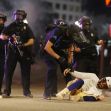On June 21, 1989, the Supreme Court voted to uphold a protestor’s right to burn the American flag for the sake of protesting. In the Texas v. Johnson case, the court voted 5-4 in favor of Gregory Lee Johnson, who burned the American flag during a protest at the Republican National Convention in Dallas, Texas, in 1984. Johnson was arrested for breaking a state law that banned the desecration of the flag. He was sentenced to a year in prison and ordered to pay a $2,000 fine. The Supreme Court said that the flag burning was symbolic and political. Therefore, it is protected by the First Amendment, even though it destroys our national symbol.
Justices William Brennan, Anthony Kennedy, Thurgood Marshall, Harry Blackmun and Antonin Scalia were in the majority. Chief Justice William Rehnquist dissented with Justices John Paul Stevens, Sandra Day O’Connor, and Byron White. Justice Brennan wrote the majority opinion, saying, “Johnson was convicted for engaging in expressive conduct. The State’s interest in preventing breaches of the peace does not support his conviction because Johnson’s conduct did not threaten to disturb the peace,” said Brennan. “Nor does the State’s interest in preserving the flag as a symbol of nationhood and national unity justify his criminal conviction for engaging in political expression.”
Justice Kennedy wrote a dissenting opinion, saying, “The hard fact is that sometimes we must make decisions we do not like. We make them because they are right, right in the sense that the law and the Constitution, as we see them, compel the result. And so great is our commitment to the process that, except in the rare case, we do not pause to express distaste for the result, perhaps for fear of undermining a valued principle that dictates the decision. This is one of those rare cases.”
Justice Rehnquist said in his dissent, “the flag is not simply another ‘idea’ or ‘point of view’ competing for recognition in the marketplace of ideas. I cannot agree that the First Amendment invalidates the Act of Congress, and the laws of 48 of the 50 States, which make criminal the public burning of the flag.”
The court battle over whether or not a person can desecrate the American flag started in 1907, with the Halter v. Nebraska case, where the Supreme Court said that two businesses could not sell beer with an American flag on the bottle according to state law. It was a unanimous decision.
In the case of Spence v. Washington in 1974, a college student was convicted for hanging a flag upside down with a peace sign made out of tape on it, which was against an improper use statute. The Supreme Court ruled that a person could not be convicted for putting tape in the shape of a peace sign on an American flag. The Court said it was protected speech under the First Amendment.
The Supreme Court passed the Flag Protection Act in 1989. After the law took effect, protestors in Seattle, Washington, and Washington, D.C., burned American flags in protest of the new act along with protesting against the federal government’s foreign and domestic policies. They were arrested and convicted. Under the terms of the new law, however, their appeals to the Supreme Court were expedited.
In 1990, the Supreme Court decided by a 5-4 decision in United States v. Eichman that flag burning was protected expression. The Court ruled that, just like in the Texas v. Johnson case, that “/f there is a bedrock principle underlying the First Amendment, it is that the government may not prohibit the expression of an idea simply because society finds the idea itself offensive or disagreeable.”
The issue of flag burning and other forms of desecration of the flag has been and continues to remain a contentious political issue.






